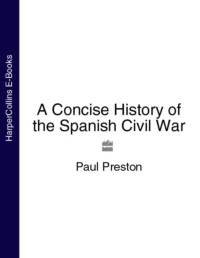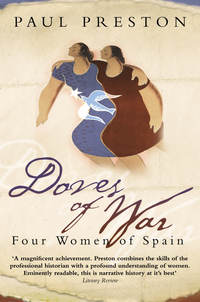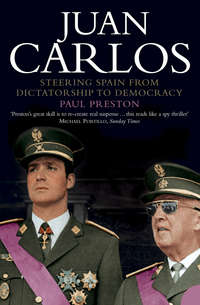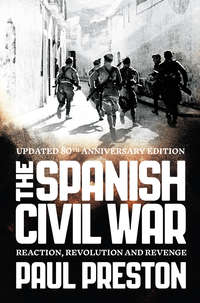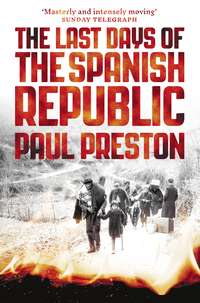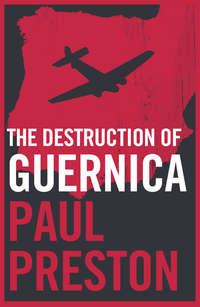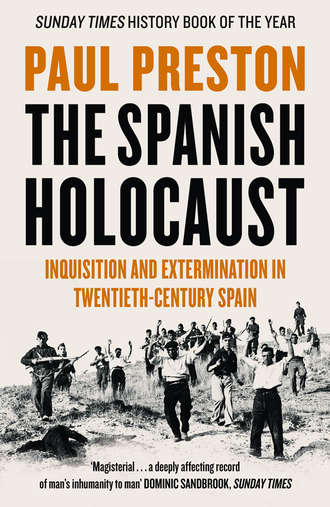
Полная версия
The Spanish Holocaust: Inquisition and Extermination in Twentieth-Century Spain
No Socialist organizations had participated in the CNT action, although a few individual militants had done so, believing it to be the ‘defensive action’ agreed on 26 November.14 In the Cortes, Prieto condemned ‘this damaging movement’. Yet, when both Gil Robles and the monarchist leader Antonio Goicoechea enthusiastically offered to help the government crush subversion, Prieto reacted angrily. It disturbed him that the ‘enemies of the Republic’ supported the regime only when the proposal was for the repression of the working class. By their determination to silence the workers’ organizations, Prieto perceptively told the deputies of the right, ‘you are closing all exits to us and inviting us to a bloody conflict’.15
On 16 December, Lerroux formed a government with the parliamentary support of the CEDA. Three days later, Gil Robles made a policy statement in the Cortes which explained that, in return for CEDA votes, he expected an amnesty for those imprisoned for Sanjurjo’s coup of August 1932 and a thorough revision of the religious legislation of the Constituent Cortes (so called because it was the parliament that elaborated and approved the Republican Constitution). Most alarming for the left were his demands for the repeal of the reforms which had most benefited the landless peasantry – the laws of municipal boundaries and of obligatory cultivation, and the introduction of the eight-hour day and of mixed juries (arbitration committees). He also demanded a reduction of the area of land subject to expropriation under the agrarian reform bill and denounced the socializing concept of settling peasants on the land. Most alarming for the left was his statement that his ambition was to lead a government and change the Constitution: ‘We are in no hurry, we want other proposals to fail so that experience will show the Spanish people that there can only be one solution, an unequivocally right-wing solution.’ Behind the measured tone, there lay a dramatic threat that, if events showed that a right-wing evolution was not possible, the Republic would pay the consequences. Not surprisingly, the Socialists regarded this as a fascist speech.16 In reply, Indalecio Prieto made it clear that, for the Socialists, the legislation that Gil Robles aimed to repeal was what made the Republic worth defending. He threatened that the Socialists would defend the Republic against Gil Robles’s dictatorial ambitions by unleashing the revolution.17 In the exchange could be seen the seeds of the violent events of October 1934.
The appalling dilemma faced by the PSOE executive was revealed by Fernando de los Ríos when he visited the ex-Prime Minister Manuel Azaña on 2 January 1934. Azaña noted in his diary:
He recounted to me the incredible and cruel persecutions that the workers’ political and union organizations were suffering at the hands of the authorities and the employers. The Civil Guard was daring to do things it had never dared do before. It was impossible to restrain the exasperation of the masses. The Socialist leaders were being overwhelmed. Where would it all end? In a great misfortune, probably. I was aware of the barbaric policy followed by the government and of the way the landowners were reducing the rural labourers to hunger and of the retaliations and reprisals against other workers. I know the slogan ‘Let the Republic feed you’ [Comed República]. But all of this and much more that De los Ríos told me, and the government’s measures, and the policy of the Radical–CEDA majority in the Cortes, which aimed only to undo the work of the Constituent Cortes, did not make it advisable, nor justifiable, for the Socialist Party and the UGT to launch themselves into a movement of force.
Azaña told De los Ríos categorically that it was the duty of the Socialist leadership, even at the risk of their own popularity, to make their followers see that an insurrection would be madness. His reason was that ‘there was no reason to expect the right to react calmly or even to limit their reaction to the re-establishment of law and order. In fact, they would abuse their victory and would go far beyond what was happening already and what they were announcing.’ Shortly afterwards, De los Ríos reported Azaña’s prophetic words to the PSOE executive committee. However, given the employers’ intransigence, it was impossible for them to tell their rank and file to be patient.18
PSOE offices received reports from all over Andalusia and Extremadura about provocations from owners and Civil Guards alike. The new government appointed several conservative provincial governors in the south, a move which was soon reflected in the law being flouted with impunity and an increase in the ‘preventive brutality’ of the Civil Guard. In El Real de la Jara, in the sierra to the north of the province of Seville, the local landowners had refused to employ union labour. A subsequent strike lasted several months and, in December 1933, some starving workers found with acorns stolen from pig troughs were savagely beaten by the Civil Guard. The Civil Governor suspended the village Mayor when he protested to the local Civil Guard commander about these abuses. In Venta de Baúl (Granada) the armed guards of the cacique, a member of the CEDA, beat up local union leaders.19
In Fuente del Maestre, Fuente de Cantos, Carmonita and Alconchel (Badajoz), it was the Civil Guard which did the beating when hungry workers were caught collecting windfall olives and acorns. Elsewhere in Badajoz, to prevent labourers being able to alleviate their hunger in this way, the owners took pigs into the fields to eat the fallen crops. Some yunteros (ploughmen) who had started to plough an abandoned estate were imprisoned and the Civil Guard occupied the Casa del Pueblo in nearby Hornachos. In contrast, nothing had been done about the deaths in the same town nine months earlier. In many pueblos, especially in Badajoz, Jaén and Córdoba, landowners ignored regulations about rotating jobs among those registered at the local labour exchange. They would give work only to those who had voted for the right and systematically refused jobs to members of the FNTT. In Almendralejo, during the grape and olive harvests, despite massive local unemployment, two thousand outside labourers were brought in. In Orellana la Vieja and Olivenza, the owners employed only women and children, who were paid a fraction of the wage normally paid to men.20
Wages had dropped by 60 per cent. Hunger was breeding desperation and hatred was building up on both sides of the social divide. In Priego de Córdoba, a delegation of union members who had had no work for four months asked the Mayor to intervene. He replied that he could not oblige anyone to give them work and advised them to go on their knees to beg the landowners for jobs. And the problem was not confined to the south. A union official from Villanueva del Rebollar in the Castilian province of Palencia wrote, ‘The caciques should be careful about their foolhardiness. Our patience is wearing thin.’ The FNTT executive made several appeals to the new Minister of Labour, Ricardo Samper, for the implementation of existing social legislation but it was to no avail.21
In late December 1933, a draft law had already been presented to the Cortes for the expulsion of peasants who had occupied land in Extremadura the previous year. In January 1934, the law of municipal boundaries was provisionally repealed. The CEDA also presented projects for the emasculation of the 1932 agrarian reform, by reducing the amount of land subject to expropriation, and for the return of land confiscated from those involved in the August 1932 military rising. Clashes between the Civil Guard and the braceros increased daily.22
Throughout January, long and often bitter discussions between the PSOE and the UGT leaderships about a possible revolutionary action in defence of the Republic culminated in the defeat of the cautious line. The leadership of the UGT passed to Largo Caballero and the younger elements who supported his ‘revolutionary’ rhetoric. With the PSOE, its youth movement – the Federación de Juventudes Socialistas – and now the UGT all in the hands of those advocating a radical line, a joint committee was immediately established to make preparations for a revolutionary movement. PSOE, UGT and FJS organizations in each province were sent seventy-three naive instructions for the creation of militias, the acquisition of arms, the establishment of links with sympathetic members of the army and the Civil Guard and the organization of technicians to run basic services. The replies received made clear the absurdly optimistic nature of these goals and, apart from the flurry of communications generated by the committee, little or no practical action was taken.23
However, the various communications were anything but clandestine. Indeed, revolutionary rhetoric from the self-proclaimed ‘Bolshevizers’ was loudly indiscreet and provided ample evidence for right-wing exaggeration about the dangers of revolutionary socialism. The raucous radicalism of the younger Socialists would be used throughout the spring and summer of 1934 to justify harsh repression of strikes that were far from revolutionary in intent. The anything but secret plan was for the revolutionary movement to be launched in the event of the CEDA being invited to participate in government. There was no link between the vaguely discussed ‘revolutionary moment’ and the needs and activities of the workers’ movement. Indeed, no thought was given to ways of harnessing the energies of organized labour for the projected revolution. Rather, the trade unionist habits of a lifetime saw Largo Caballero persuade the new UGT executive on 3 February to do nothing to stop any conventional strike action which was then treated by the authorities as subversive.24
One of the most far-reaching consequences of Largo Caballero’s confused swerve to the left would be visited upon the rural proletariat. At a meeting of the national committee of the landworkers’ union, the Federación Nacional de Trabajadores de la Tierra, on 30 January 1934, the moderate executive committee resigned and was replaced in its entirety by young radicals led by the representative of Navarre, Ricardo Zabalza Elorga.25 The new secretary general Zabalza was a tall, handsome, bespectacled and rather shy thirty-six-year-old union official. He was born in Erratzu in the north of Navarre. The poverty of his family had obliged him, aged fifteen, to emigrate to Argentina. There, he had worked in appalling conditions which had impelled him to become a trade unionist. Always committed to self-education, he had managed to become a schoolteacher and eventually a headmaster. He returned to Spain in 1929. Living in Jaca in the Pyrenees, he had become an enthusiastic activist of the UGT. In 1932, he had moved to the Navarrese capital, Pamplona, where he worked hard to establish a local FNTT branch. The right in Navarre was among the most dominant and brutal of any province in Spain and had blatantly flouted Republic social and labour legislation. After the electoral victory of the right-wing coalition, in Navarre, as in the south, the local landlords refused work to union members and ignored existing social legislation.26
The new Radical government was impelled, both by the inclinations of its more conservative members and by its dependence on CEDA votes, to defend the interests of the landowners. Its arrival in power just as the strength of fascism was growing in Germany and Italy fostered the belief within the Socialist movement that only a revolutionary insurrection could prevent the establishment of a right-wing dictatorship. Within the FNTT, Zabalza began to advocate a general strike in order to put a stop to the employers’ offensive. Older heads within the UGT were opposed to what they saw as a rash initiative which might, moreover, weaken a future rising against a possible attempt to establish an authoritarian state. Suspicion of the right’s intentions had intensified with the appointment at the beginning of March of the thirty-nine-year-old Rafael Salazar Alonso as Minister of the Interior.
Salazar Alonso hastened to convene those of his subordinates responsible for public order and outline his ‘anti-revolutionary’ plans. The head of the Civil Guard was Brigadier General Cecilio Bedia de la Cavallería. In charge of the police and the Assault Guards was the Director General of Security, Captain José Valdivia Garci-Borrón, a crony of Alejandro Lerroux and a man of strong reactionary instincts. Valdivia reassured Salazar Alonso that they could rely implicitly on the head of the Assault Guards, the hard-line Africanista Lieutenant Colonel Agustín Muñoz Grandes, a man who would rise to be Vice-President in Franco’s government. Valdivia reported equally favourably on the Civil Guard Captain Vicente Santiago Hodson, the fiercely anti-leftist head of the intelligence service founded by General Mola and a colleague of the sinister Julián Mauricio Carlavilla. To have such reactionary individuals at his command well suited Salazar Alonso’s repressive ambitions.27 Salazar Alonso made it clear to a delighted General Bedia de la Cavallería that the Civil Guard need not be inhibited in its interventions in social conflicts.28 It was hardly surprising that, when a series of strikes by individual unions took place in the spring of 1934, Salazar Alonso seized the excuse for heavy-handed action. One after another, in the printing, construction and metallurgical industries, the strikes led at best to stalemate, and often to ignominious defeat.
The right could hardly have been more pleased with Salazar Alonzo. On 7 March he declared a state of emergency and closed down the headquarters of the Socialist Youth, the Communist Party and the anarcho-syndicalist CNT. His energy was applauded by Gil Robles, who declared that, as long as the Minister of the Interior thus defended the social order and strengthened the principle of authority, the government was assured of CEDA support. A series of articles in El Debate stressed that this meant severe measures against what the paper called the ‘subversion’ of workers who protested against wage cuts. When the CEDA press demanded the abolition of the right to strike, Lerroux’s government responded by announcing that strikes with political implications would be ruthlessly suppressed. For both the right-wing press and Salazar Alonso, all strikes were deemed to be political. On 22 March El Debate denounced stoppages by waiters in Seville and by transport workers in Valencia as ‘strikes against Spain’, and called for anti-strike legislation as draconian as that of Fascist Italy, Nazi Germany and Salazar’s Portugal. The government extended its repressive armoury by expanding the Civil Guard and the Assault Guard and by re-establishing the death penalty, which had been abolished in 1932.29
Not everyone on the right was as contented as Gil Robles. The co-creator of the fascist JONS (Juntas de Ofensiva Nacional Sindicalista), Onésimo Redondo, found comfort neither in the right’s electoral success of November 1933 nor in the efforts of Salazar Alonso. In January 1934, he wrote: ‘Get your weapons ready. Learn to love the metallic clunk of the pistol. Caress your dagger. Never be parted from your vengeful cudgel!’ ‘The young should be trained in physical struggle, must love violence as a way of life, must arm themselves with whatever they can and finish off by any means the few dozen Marxist swindlers who don’t let us live.’30
The weakness of the JONS impelled Onésimo and Ramiro Ledesma Ramos to seek like-minded partners. This led, in mid-February 1934, to the fusion of the JONS with the Falange Española, the small fascist party led by the aristocratic José Antonio Primo de Rivera.31 Neither Redondo nor Ledesma Ramos was bothered that, two months before its official launch on Sunday 29 October 1933, Falange Española had accepted funding from the most conservative sectors of the old patrician right. The agreement known as the Pacto de El Escorial made by José Antonio Primo de Rivera with the monarchists of Renovación Española tied the Falange to the military conspiracy against the Republic.32 The monarchists’ were ready to finance the Falange because they saw its utility as an instrument of political destabilization.
Redondo and Ledesma Ramos were probably reassured by the fact that, when recruiting started for the Falange, new militants had been required to fill in a form which asked if they had a bicycle – a euphemism for pistol – and were then issued with a truncheon. The training of the Falange militia had been placed in the hands of the veteran Africanista Lieutenant Colonel Ricardo de Rada, who was also the National Inspector of the Requeté and heavily involved in conspiracy against the Republic.33 In his inaugural speech, José Antonio declared the new party’s commitment to violence: ‘if our aims have to be achieved by violence, let us not hold back before violence … The dialectic is all very well as a first instrument of communication. But the only dialectic admissible when justice or the Fatherland is offended is the dialectic of fists and pistols.’34 Although violence was becoming a commonplace of the politics of Spain in the 1930s, no party exceeded the Falange in its rhetoric of ‘the music of pistols and the barbaric drumbeat of lead’. The representation of political assassination as a beautiful act and death in street-fighting as a glorious martyrdom was central to the funeral rituals which, in emulation of the practice of the Italian Fascist Squadristi, followed the participation of Falangists in street violence.35
The merger of the Falange and the JONS, under the interminable name of Falange Española de las Juntas de Ofensiva Nacional Sindicalista, was announced in Valladolid on 4 March 1934 at the Teatro Calderón. Coachloads of Falangists from Madrid and the other Castilian provinces converged on Valladolid. The local left had declared a general strike, and mounted police in the streets outside held back hostile workers. Inside the theatre, bedecked with the black and red flags of FE de las JONS, a forest of stiffly outstretched arms greeted the orators with the fascist salute. The provocative speeches delivered by Onésimo and José Antonio Primo de Rivera fired up the audience to rush out and fight the workers in the streets. Shots were fired and, at the end of the day, with many broken heads on both sides, there was one Falangist dead. Those leftists involved who could be identified would be shot by the rebels during the Civil War.36
Shortly after these events in Valladolid, a joint delegation of Alfonsine and Carlist monarchists would arrive in Rome on 31 March seeking financial help and weaponry for their attempts to overthrow the Republic. The delegation included Antonio Goicoechea, now head of the recently created party Renovación Española, which advocated the return of King Alfonso XIII, General Emilio Barrera, of the conspiratorial Unión Militar Española, and Antonio Lizarza Iribarren, the recruiter for the Carlist Requeté. Mussolini offered financial assistance to the tune of 1.5 million pesetas and 20,000 rifles, 20,000 hand grenades and 200 machine-guns which were delivered via Tripoli and Portugal. Arrangements were also made for several hundred Requetés (Carlist militiamen) to be trained by the Italian Army as instructors.37 Under its newly elected leader, Manuel Fal Conde, the Carlist movement (the Comunión Tradicionalista) was creating a full-scale citizen army. For the Carlist youth organization, ‘sick of legality’, violence was seen as a quintessential part of the Carlist way of life. The result of the efforts of Rada and Colonel José Enrique Varela was that, by the spring of 1936, the Comunión Tradicionalista could offer the military conspirators a well-trained, well-armed force of 30,000 ‘red berets’. With 8,000 men in Navarre and 22,000 in Andalusia and elsewhere, the Requeté constituted a crucial military contribution to the rising.38
On 22 April 1934, the youth organization of the CEDA, the Juventud de Acción Popular, organized a fascist-style rally at Philip II’s monastery of El Escorial, a choice of venue that was a provocatively anti-Republican gesture. In driving sleet, 20,000 gathered in a close replica of the Nazi rallies. They swore loyalty to Gil Robles ‘our supreme chief’ and chanted, ‘¡Jefe! ¡Jefe! ¡Jefe!’ – the Spanish equivalent of Duce. The JAP’s nineteen-point programme was recited, with emphasis on point two, ‘our leaders never make mistakes’, a direct borrowing from the Italian Fascist slogan ‘Il Duce sempre ha raggione.’ Luciano de la Calzada, CEDA deputy for Valladolid, spoke in Manichaean terms identical to those that would be used by the Francoists during the Civil War. He asserted that ‘Jews, heretics, Protestants, admirers of the French revolution, Freemasons, liberals and Marxists’ were ‘outside and against the Fatherland and are the anti-Fatherland’.39
In April 1934, the monarchist aviator and playboy Juan Antonio Ansaldo had joined the Falange at the invitation of José Antonio. He was given the task of organizing terrorist squads. José Antonio particularly wanted reprisals for left-wing attacks on the vendors of the Falange newspaper, F.E. Ansaldo’s efforts to arrange more violent activities by the so-called ‘Falange of Blood’ were welcomed by the leaders of the JONS. Ledesma Ramos wrote: ‘His presence in the party was of undeniable utility because he mobilized that active, violent sector which the reactionary spirit produces everywhere as one of the most fertile ingredients for the national armed struggle. Remember what similar groups meant for German Hitlerism especially in its early stages.’ On 3 June, two thousand armed escuadristas gathered at Carabanchel aerodrome outside Madrid. A bus company which had refused to take a further three hundred to the meeting had two of its coaches destroyed by fire.40
In fact, the right, at this stage, had little need for a violent fascist party. The CEDA’s landed backers had achieved a great victory with the definitive repeal of the law of municipal boundaries. The position of the CEDA had been strengthened on 25 April 1934 when Lerroux offered to resign in protest at Alcalá Zamora’s delay in signing the amnesty for those imprisoned after the Sanjurjada. It had not occurred to Lerroux that the President might accept his offer. When he did, Lerroux felt obliged, to avoid the possibility of Alcalá Zamora calling new elections, to give permission to Ricardo Samper to form a government. He did so in the confidence that Samper’s indecisiveness would let him continue to govern from the shadows. Lerroux’s support for the amnesty and the general rightwards trend of the Radical Party saw its deputy leader, Diego Martínez Barrio, leave, taking with him nineteen of its most liberal parliamentary deputies. Thus the Radical Party shifted even further to the right and was left even more dependent on Gil Robles. This made possible the repeal of the law of municipal boundaries on 23 May.41
Coming just before the harvest was due to start, this allowed the owners to bring in Portuguese and Galician labour to undercut the wages of local workers who already faced starvation. The last vestige of protection that left-wing landless labourers had for their jobs and their wages was that provided by the Socialist majorities on many town and village councils. Socialist mayors were the only hope that rural workers had of landowners being obliged to observe social legislation or of municipal funds being used for public works to provide some employment. When the Radicals came into power in late 1933, Lerroux’s first Minister of the Interior, Manuel Rico Avello, removed thirty-five of them. Salazar Alonso began to remove many more, usually on flimsy pretexts such as ‘administrative irregularities’ – which often referred to debts inherited from their monarchist predecessors. As soon as he took up office, in response to petitions from local caciques, he ordered provincial civil governors to remove mayors who ‘did not inspire confidence in matters of public order’ – which usually meant Socialists. The legally elected mayor would then be replaced by a ‘government delegate’, usually a local conservative nominee.
Some of Salazar Alonso’s most drastic interventions were in Extremadura, which was partly explained by his infatuation with the local aristocracy. In his memoirs, he admitted removing 193 southern town councils over the next six months. The procedure was that, after a denunciation of some irregularity, however small or implausible, a ‘delegate’ of the Civil Governor, accompanied by the Civil Guard and representatives of the local right, would expel the Socialist mayor and councillors. The majority of the ‘delegates’ were either caciques or their appointees. The idea was to put an end to a situation in which Socialist councils endeavoured to ensure the implementation of social legislation, particularly work-sharing. Once the change had taken place, the new mayors did nothing to protect workers, either from the capricious employment policies of the caciques or from the attacks of their retainers and the Civil Guard.42


